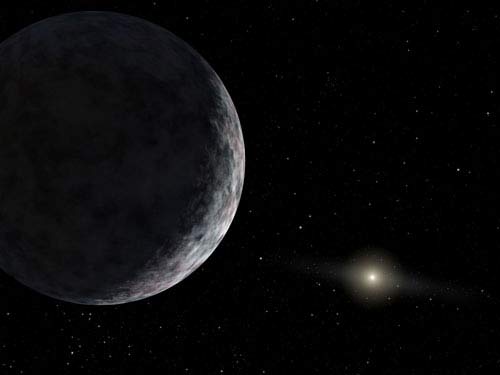Study Confirms '10th Planet' Indeed Larger than Pluto

An object discoveredearlier this year and considered by some to be our solar system's 10thplanet is indeed larger than Pluto, a new study confirms.
The object, catalogued as 2003UB313, is by many accounts a planet. It is round and orbits the Sun.
But because several other objects meet those criteria andalso approach Pluto's size, astronomers have been wranglingfor months over how to define the word "planet." It is not known if or whenthe International Astronomical Union, which rules on such things, will issue adecision. Members of an advisory board weighing the issue can't even agree onthe parameters of a definition.
Meanwhile, 2003 UB313 is now known to be about 1,860 miles(3,000 kilometers) in diameter, give or take 190 miles (300 kilometers).
Pluto is 1,430 miles (2,300 kilometers) wide.
The object's size was initially calculated based on anestimate of how much sunlight it reflects. But astronomers don't know exactlywhat its surface is made of, so they could not be sure how reflective it is.
The new study, led by Frank Bertoldi from the University ofBonn, relies on new observation of 2003 UB313's thermal emission. Thecalculations are based on the object's size and its surface temperature, whichcan be estimated based on the object's distance from the Sun.
Get the Space.com Newsletter
Breaking space news, the latest updates on rocket launches, skywatching events and more!
The results are detailed in the Feb. 2 issue of the journal Nature.
"Since UB313 is decidedly larger than Pluto,"Bertoldi said, "it is now increasingly hard to justify calling Pluto aplanet if UB313 is not also given this status."
But 2003 UB313 is much farther away. Its elongated orbittakes it far out into the icy KuiperBelt, twice as far from the Sun as Pluto. Many astronomers now say Plutois a Kuiper Belt Object and should never have been called a planet.
So if 2003 UB313 is termed a planet, as some suggest, then ahandful of other good-sized, round worlds known to exist--and perhaps hundredsyet to be found in the Kuiper Belt--would also have to be called planets. Amongthe other candidates: Sedna,which is about three-fourths as large as Pluto, 2004 DWand Quaoar.
One suggestion is to call the outer worlds "dwarf planets."
Scott Sheppard of the Carnegie Institute of Washington takesthis view:
"Whichever way you care to count them, with the discoveryand measurement of the size of 2003 UB313 there are no longer nine majorplanets in the solar system," Sheppard writes in an analysis for Nature.
Sheppard also notes a surprise that's come from this studyand others recently.
Astronomers have now accurately measured the diameter andreflectiveness, or albedo, of a handful of Kuiper Belt Objects.
"It seems that the largest objects have the highestalbedos," Sheppard said. "This could be because gravity on these objects islarge enough for them to have active atmospheres and so be able to retainvolatile gaseous substances that could brighten their surfaces."
- The Discovery of 2003 UB313
- The Debate over 2003 UB313 and Planet Definition
- Crazy Names: The Solar System's Nomenclature Wars
Join our Space Forums to keep talking space on the latest missions, night sky and more! And if you have a news tip, correction or comment, let us know at: community@space.com.

Rob has been producing internet content since the mid-1990s. He was a writer, editor and Director of Site Operations at Space.com starting in 1999. He served as Managing Editor of LiveScience since its launch in 2004. He then oversaw news operations for the Space.com's then-parent company TechMediaNetwork's growing suite of technology, science and business news sites. Prior to joining the company, Rob was an editor at The Star-Ledger in New Jersey. He has a journalism degree from Humboldt State University in California, is an author and also writes for Medium.









